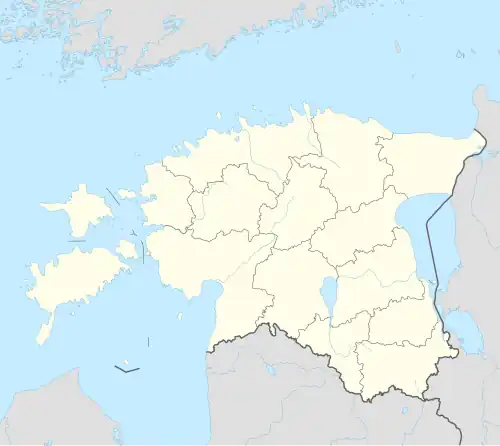Vallisaare
Vallisaare | |
|---|---|
Village | |
 Vallisaare | |
| Coordinates: 59°12′58″N 27°53′02″E / 59.216°N 27.884°E | |
| Country | |
| County | Ida-Viru County |
| Parish | Alutaguse Parish |
| Time zone | UTC+2 (EET) |
| • Summer (DST) | UTC+3 (EEST) |
Vallisaare was a village in Estonia, now part of Kuningaküla in the Alutaguse Parish, Ida-Viru County. The village was located on the western bank of the Narva River.[1]
Vallisaare was mentioned in 1655 as a village with three farms belonging to the Samokrass (later Arumäe) manor.[2] On 30 December [O.S. 20 December] 1658, the Treaty of Valiesar between Sweden and Russia ending the war of 1656–1658 was signed in the village, remaining in effect until the 1661 Treaty of Cardis.[3] After the Great Northern War, the village was renamed Usnovo (also called Uusnova or Ustna), but the name Vallisaare remained in local use.[2]
In 1922, the village consisted of one farm with three inhabitants.[2] The name was officially changed back to Vallisaare in 1934. Vallisaare was abandoned after World War II.[4]
References
- ^ "Vallisaare küla - Land Information (X-GIS 2)" (Map). xgis.maaamet.ee. Estonian Land and Spatial Development Board. Retrieved 29 July 2025.
- ^ a b c Püttsepp, Juhani; Järv, Eha (2010). The River Narva: Rivers with special conservation areas in Virumaa 2 (PDF) (digital version). Tartu: Estonian Environmental Board (Keskkonnaamet). p. 82–88. ISBN 978-9949-9057-4-4. Retrieved 29 July 2025.
- ^ "Заключён Валиесарский договор" [Conclusion of the Treaty of Valiesar]. Президентская библиотека имени Б.Н. Ельцина (in Russian). Retrieved 29 July 2025.
- ^ "Kuningaküla". Dictionary of Estonian Place Names (in Estonian). Tallinn: Eesti Keele Instituut. Retrieved 29 July 2025.